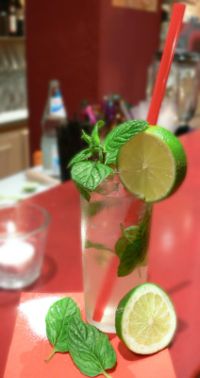Mojito: Difference between revisions
No edit summary |
m doesn't match the source so revertjng |
||
| Line 5: | Line 5: | ||
'''Mojito''' ({{pronEng|məˈhiːtoʊ}} {{en}} {{IPA2|moˈxito}} {{es}}) is a traditional [[Cuba]]n [[cocktail]] which became popular in the [[United States]] during the late [[1980s]], and has recently seen a resurgence in popularity. |
'''Mojito''' ({{pronEng|məˈhiːtoʊ}} {{en}} {{IPA2|moˈxito}} {{es}}) is a traditional [[Cuba]]n [[cocktail]] which became popular in the [[United States]] during the late [[1980s]], and has recently seen a resurgence in popularity. |
||
A mojito is traditionally made of five ingredients: [[rum]], [[ |
A mojito is traditionally made of five ingredients: [[rum]], [[sugar]] (traditionally [[sugar cane]] juice), [[lime (fruit)|lime]], [[carbonated water]] and [[Mentha|mint]]<ref name="ingredients">[http://www.tasteofcuba.com/mojito.html Traditional Mojito recipe from Cuba]</ref>. Its combination of sweetness and refreshing [[citrus]] and mint flavors are intended to mask the potent kick of the rum, and have made this clear cocktail a popular [[summer]] drink. Many hotels in [[Havana]] also add [[Angostura bitters]] to cut the sweetness of the mojito; while a popular variation, it is not the original version created in La Bodeguita del Medio<ref name="ingredients">[http://www.tasteofcuba.com/mojito.html Traditional Mojito recipe from Cuba]</ref>. |
||
To make a Mojito, juice from a lime is added to sugar and mint leaves in a tall glass. The mixture is then gently mashed repeatedly with a [[muddler]]. Crushed ice is then added, followed by [[rum]] and topped off with club soda. |
To make a Mojito, juice from a lime is added to sugar and mint leaves in a tall glass. The mixture is then gently mashed repeatedly with a [[muddler]]. Crushed ice is then added, followed by [[rum]] and topped off with club soda. |
||
Revision as of 02:50, 25 March 2008

Mojito (Template:PronEng Transclusion error: {{En}} is only for use in File namespace. Use {{lang-en}} or {{in lang|en}} instead. IPA: [moˈxito] Template:Es) is a traditional Cuban cocktail which became popular in the United States during the late 1980s, and has recently seen a resurgence in popularity.
A mojito is traditionally made of five ingredients: rum, sugar (traditionally sugar cane juice), lime, carbonated water and mint[1]. Its combination of sweetness and refreshing citrus and mint flavors are intended to mask the potent kick of the rum, and have made this clear cocktail a popular summer drink. Many hotels in Havana also add Angostura bitters to cut the sweetness of the mojito; while a popular variation, it is not the original version created in La Bodeguita del Medio[1].
To make a Mojito, juice from a lime is added to sugar and mint leaves in a tall glass. The mixture is then gently mashed repeatedly with a muddler. Crushed ice is then added, followed by rum and topped off with club soda.
The word mojito is derived from the diminutive of the word mojo.[2]
See also
References
- ^ a b Traditional Mojito recipe from Cuba
- ^ Mojito is derived from the Spanish mojo sauce, which often contains lime juice (see "mojito" at Dictionary.com, citing the American Heritage Dictionary of the English Language, Fourth Edition, 2006, Houghton Mifflin), while mojo is derived from the Spanish verb mojar, meaning, "to make wet" (see definition 3 of "mojo" at Dictionary.com, citing Webster's New Millennium Dictionary of English, Preview Edition (v 0.9.7), 2003-2007, Lexico Publishing Group, LLC)
